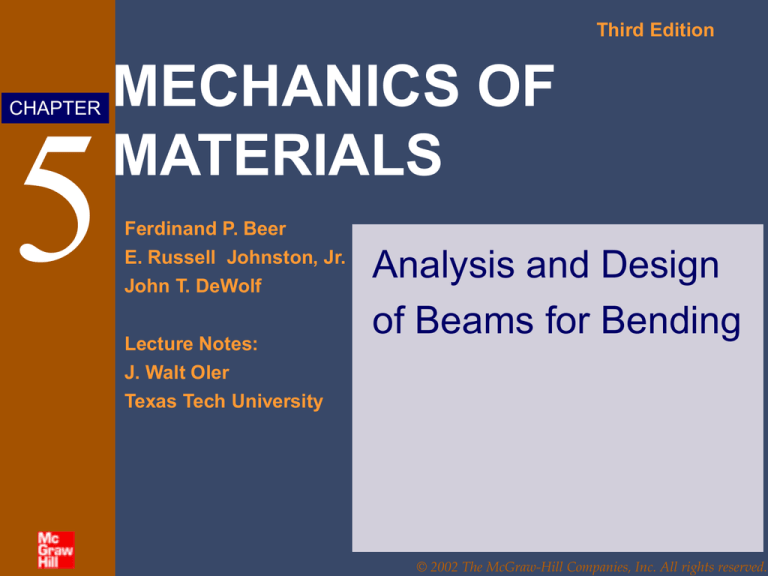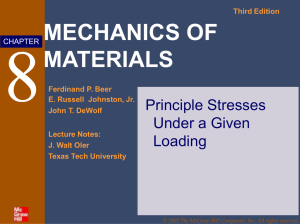
Third Edition
CHAPTER
5
MECHANICS OF
MATERIALS
Ferdinand P. Beer
E. Russell Johnston, Jr.
John T. DeWolf
Lecture Notes:
J. Walt Oler
Texas Tech University
Analysis and Design
of Beams for Bending
© 2002 The McGraw-Hill Companies, Inc. All rights reserved.
Third
Edition
MECHANICS OF MATERIALS
Beer • Johnston • DeWolf
Analysis and Design of Beams for Bending
Introduction
Shear and Bending Moment Diagrams
Sample Problem 5.1
Sample Problem 5.2
Relations Among Load, Shear, and Bending Moment
Sample Problem 5.3
Sample Problem 5.5
Design of Prismatic Beams for Bending
Sample Problem 5.8
© 2002 The McGraw-Hill Companies, Inc. All rights reserved.
5-2
Third
Edition
MECHANICS OF MATERIALS
Beer • Johnston • DeWolf
Introduction
• Objective - Analysis and design of beams
• Beams …………………………………………………
……….
• Transverse loadings of beams are classified as
……………….loads or …………………. loads
• Applied loads result in internal forces consisting
of a shear force (from the shear stress
distribution) and a bending couple (from the
normal stress distribution)
• Normal stress is often the critical design criteria
σx = −
My
I
σm =
Mc M
=
I
S
Requires determination of the location and
magnitude of largest bending moment
© 2002 The McGraw-Hill Companies, Inc. All rights reserved.
5-3
Third
Edition
MECHANICS OF MATERIALS
Beer • Johnston • DeWolf
Introduction
Classification of Beam Supports
© 2002 The McGraw-Hill Companies, Inc. All rights reserved.
5-4
Third
Edition
MECHANICS OF MATERIALS
Beer • Johnston • DeWolf
Shear and Bending Moment Diagrams
• ……………………………………………
……………………………………………
……………………………………………
• ………………………………………………
………………………………………………
………………………………………………
………………………………………………
• ……………………………………………
……………………………………………
……………………………………………
© 2002 The McGraw-Hill Companies, Inc. All rights reserved.
5-5
Third
Edition
MECHANICS OF MATERIALS
Beer • Johnston • DeWolf
Sample Problem 5.1
SOLUTION:
• ……………………………………
……………………………………
• ……………………………………
……………………………………
……………………………………
……………………………………
For the timber beam and loading
shown, draw the shear and bendmoment diagrams and determine the
maximum normal stress due to
bending.
• ……………………………………
……………………………………
……………………………………
• ……………………………………
…………………………………….
© 2002 The McGraw-Hill Companies, Inc. All rights reserved.
5-6
Third
Edition
MECHANICS OF MATERIALS
Beer • Johnston • DeWolf
Sample Problem 5.1
SOLUTION:
• Treating the entire beam as a rigid body, determine
the reaction forces
• Section the beam and apply equilibrium analyses
on resulting free-bodies
© 2002 The McGraw-Hill Companies, Inc. All rights reserved.
5-7
Third
Edition
MECHANICS OF MATERIALS
Beer • Johnston • DeWolf
Sample Problem 5.1
• Identify the maximum shear and bendingmoment from plots of their distributions.
• Apply the elastic flexure formulas to
determine the corresponding
maximum normal stress.
© 2002 The McGraw-Hill Companies, Inc. All rights reserved.
5-8
Third
Edition
MECHANICS OF MATERIALS
Beer • Johnston • DeWolf
Sample Problem 5.2
SOLUTION:
• ………………………………………
………………………………………
……………………………………..
• ……………………………………
……………………………………
……………………………………
The structure shown is constructed of a
……………………………………
W10x112 rolled-steel beam. (a) Draw
…………………………………….
the shear and bending-moment diagrams
for the beam and the given loading. (b)
determine normal stress in sections just
• ………………………………………
to the right and left of point D.
………………………………………
………………………………………
………………………………………
© 2002 The McGraw-Hill Companies, Inc. All rights reserved.
5-9
Third
Edition
MECHANICS OF MATERIALS
Beer • Johnston • DeWolf
Sample Problem 5.2
SOLUTION:
• Replace the 10 kip load with equivalent forcecouple system at D. Find reactions at B.
• Section the beam and apply equilibrium
analyses on resulting free-bodies.
© 2002 The McGraw-Hill Companies, Inc. All rights reserved.
5 - 10
Third
Edition
MECHANICS OF MATERIALS
Beer • Johnston • DeWolf
Sample Problem 5.2
• Apply the elastic flexure formulas to
determine the maximum normal stress to
the left and right of point D.
From Appendix C for a W10x112 rolled
steel shape, S = 126 in3 about the X-X axis.
© 2002 The McGraw-Hill Companies, Inc. All rights reserved.
5 - 11
Third
Edition
MECHANICS OF MATERIALS
Beer • Johnston • DeWolf
Relations Among Load, Shear, and Bending Moment
• Relationship between load and shear:
∑ Fy = 0 : V − (V + ∆V ) − w ∆x = 0
∆V = − w ∆x
dV
= −w
dx
xD
VD − VC = − ∫ w dx
xC
• Relationship between shear and bending
moment:
∑ M C′ = 0 :
(M + ∆M ) − M − V ∆x + w∆x ∆x = 0
∆M = V ∆x − 12 w (∆x )
2
2
dM
=0
dx
xD
M D − M C = ∫ V dx
xC
© 2002 The McGraw-Hill Companies, Inc. All rights reserved.
5 - 12
Third
Edition
MECHANICS OF MATERIALS
Beer • Johnston • DeWolf
Sample Problem 5.3
SOLUTION:
• Taking the entire beam as a free body,
determine the reactions at A and D.
• Apply the relationship between shear and
load to develop the shear diagram.
Draw the shear and bending
moment diagrams for the beam
and loading shown.
• Apply the relationship between bending
moment and shear to develop the bending
moment diagram.
© 2002 The McGraw-Hill Companies, Inc. All rights reserved.
5 - 13
Third
Edition
MECHANICS OF MATERIALS
Beer • Johnston • DeWolf
Sample Problem 5.3
SOLUTION:
• Taking the entire beam as a free body, determine the
reactions at A and D.
• Apply the relationship between shear and load to
develop the shear diagram.
© 2002 The McGraw-Hill Companies, Inc. All rights reserved.
5 - 14
Third
Edition
MECHANICS OF MATERIALS
Beer • Johnston • DeWolf
Sample Problem 5.3
• Apply the relationship between bending
moment and shear to develop the bending
moment diagram.
© 2002 The McGraw-Hill Companies, Inc. All rights reserved.
5 - 15
Third
Edition
MECHANICS OF MATERIALS
Beer • Johnston • DeWolf
Sample Problem 5.5
SOLUTION:
• Taking the entire beam as a free body,
determine the reactions at C.
• Apply the relationship between shear
and load to develop the shear diagram.
Draw the shear and bending moment
diagrams for the beam and loading
shown.
• Apply the relationship between
bending moment and shear to develop
the bending moment diagram.
© 2002 The McGraw-Hill Companies, Inc. All rights reserved.
5 - 16
Third
Edition
MECHANICS OF MATERIALS
Beer • Johnston • DeWolf
Sample Problem 5.5
SOLUTION:
• Taking the entire beam as a free body,
determine the reactions at C.
∑ Fy = 0 = − 12 w0 a + RC
a
∑ M C = 0 = 12 w0 a L − + M C
3
RC = 12 w0 a
a
M C = − 12 w0 a L −
3
Results from integration of the load and shear
distributions should be equivalent.
• Apply the relationship between shear and load
to develop the shear diagram.
a
2
x
x
VB − V A = − ∫ w0 1 − dx = − w0 x −
a
2a
0
0
a
VB = − 12 w0 a = − ( area under load curve )
- No change in shear between B and C.
- Compatible with free body analysis
© 2002 The McGraw-Hill Companies, Inc. All rights reserved.
5 - 17
Third
Edition
MECHANICS OF MATERIALS
Beer • Johnston • DeWolf
Sample Problem 5.5
• Apply the relationship between bending moment
and shear to develop the bending moment
diagram.
a
2
x 2 x3
x
M B − M A = ∫ − w0 x − dx = − w0 −
2a
0
2 6a 0
a
M B = − 13 w0 a 2
L
(
)
M B − M C = ∫ − 12 w0 a dx = − 12 w0 a(L − a )
a
a w0
a
M C = − 16 w0 a(3L − a ) =
L−
2
3
Results at C are compatible with free-body
analysis
© 2002 The McGraw-Hill Companies, Inc. All rights reserved.
5 - 18
Third
Edition
MECHANICS OF MATERIALS
Beer • Johnston • DeWolf
Design of Prismatic Beams for Bending
• The largest normal stress is found at the surface where the
maximum bending moment occurs.
M max c M max
σm =
=
I
S
• A safe design requires that the maximum normal stress be
less than the allowable stress for the material used. This
criteria leads to the determination of the minimum
acceptable section modulus.
σ m ≤ σ all
S min =
M max
σ all
• Among beam section choices which have an acceptable
section modulus, the one with the smallest weight per unit
length or cross sectional area will be the least expensive
and the best choice.
© 2002 The McGraw-Hill Companies, Inc. All rights reserved.
5 - 19
Third
Edition
MECHANICS OF MATERIALS
Beer • Johnston • DeWolf
Sample Problem 5.8
SOLUTION:
• ………………………………………
……………………………………..
A simply supported steel beam is to
carry the distributed and concentrated
loads shown. Knowing that the
allowable normal stress for the grade
of steel to be used is 160 MPa, select
the wide-flange shape that should be
used.
• ………………………………………
………………………………………
………………………………………
• ………………………………………
………………………………………
………………………………………
………………………………………
© 2002 The McGraw-Hill Companies, Inc. All rights reserved.
5 - 20
Third
Edition
MECHANICS OF MATERIALS
Beer • Johnston • DeWolf
Sample Problem 5.8
• Considering the entire beam as a free-body,
determine the reactions at A and D.
• Develop the shear diagram and determine the
maximum bending moment.
• Maximum bending moment occurs at
V = 0 or x = 2.6 m.
© 2002 The McGraw-Hill Companies, Inc. All rights reserved.
5 - 21
Third
Edition
MECHANICS OF MATERIALS
Beer • Johnston • DeWolf
Sample Problem 5.8
• Determine the minimum acceptable beam
section modulus.
• Choose the best standard section which meets
this criteria.
Shape
S , mm3
W410 × 38.8
637
W360 × 32.9
474
W310 × 38.7
549
W250 × 44.8
535
W200 × 46.1
448
© 2002 The McGraw-Hill Companies, Inc. All rights reserved.
5 - 22



